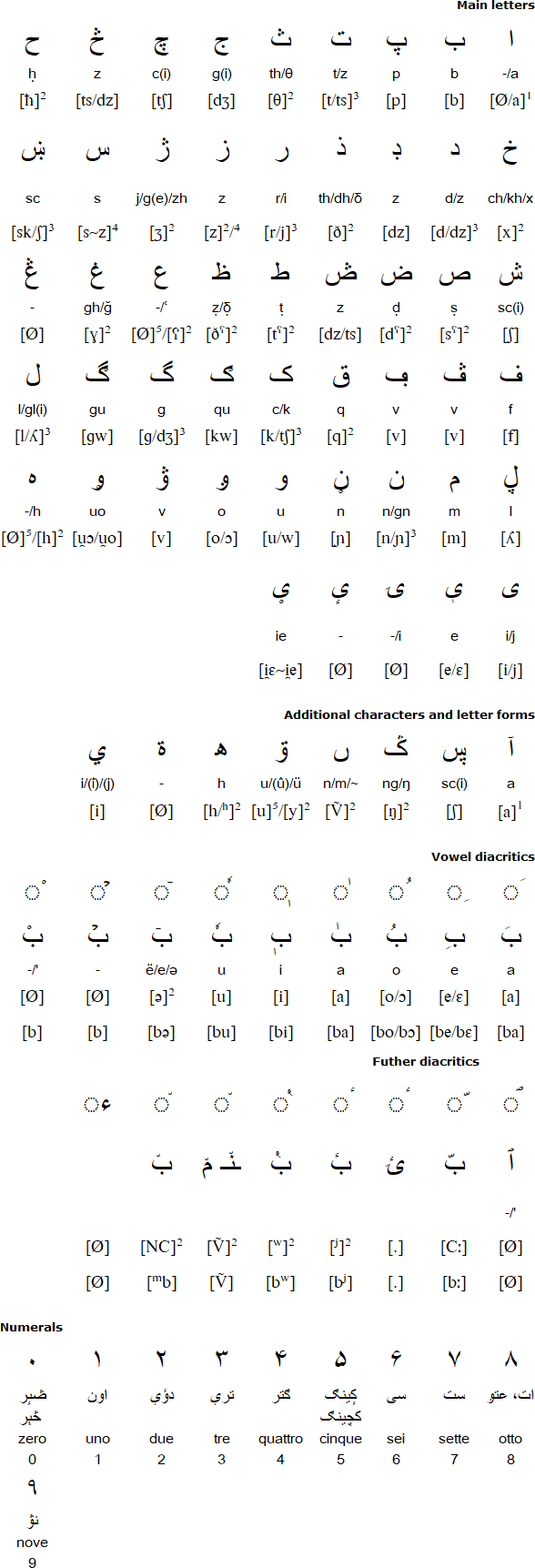Italarab is a way to write Italian with the Arabic alphabet devised by Pamir Martini in 2020, and revised in 2023. It is also known as the Arabic alphabet for the Italian language.

Download an alphabet chart for Italarab (Excel)
A more detailed description of Italarab (PDF)
لایتلیة عهء اون رپوبلیك دېمكرتیك، فندات سوللڢࢫر. لاسڢرانیتىٕ اپرتؠن آلپپل، كه لااسرچیت نلېفࢫرمې عه نیلیمیتی دېلاكࢫستیتوتٕیࢫن.
توتی ڸعسېری هومانی ناښن لیبری عد اېڰالی این دیڼیتىٕ عه دیریتی. اسی سن دࢫتاتی دی رجࢫن عه دی كࢫشنتٕ عه دېڢن اجیر ڸاونی ۋرس ڸالتری این سپیریت دی فراتلنتٕ.
L'Italia è una Repubblica democratica, fondata sul lavoro. La sovranità appartiene al popolo, che la esercita nelle forme e nei limiti della Costituzione.
Italy is a democratic Republic founded on labour. Sovereignty belongs to the people, who exercise it in the forms and within the limits laid down by the Constitution.
(Article 1 from the Constitution of the Italian Republic)
لْایتَلۡیَة عِهء اونَ رِپوبّۡلیكَ دېمُكۡرَتیكَ، فُنۡداتَ سولۡلَڢࢫرُ. لاسُڢۡرانیتٰىٕ اَپَّرۡتؠنِ آلۡپُپُلُ، كِه لااِسِرۡچیتَ نِلّېفࢫرۡمې عِه نِیۡلیمیتی دېلّاكࢫسۡتیتوتٕۡیࢫنِ.
توتّی ڸْعِسّېری هومانی ناښُنُ لیبِری عِد اېڰالی این دیڼّیتٰىٕ عِه دیریتّی. اِسّی سُنُ دࢫتاتی دی رَجࢫنِ عِه دی كࢫشِّنتَٕ عِه دېڢُنُ اَجیرِ ڸْاونی ۋِرسُ ڸْاَلتری این سپیریتُ دی فراتِلَّنتَٕ.
Tutti gli esseri umani nascono liberi ed eguali in dignità e diritti. Essi sono dotati di ragione e di coscienza e devono agire gli uni verso gli altri in spirito di fratellanza.
All human beings are born free and equal in dignity and rights. They are endowed with reason and conscience and should act towards one another in a spirit of brotherhood.
(Article 1 of the Universal Declaration of Human Rights)
Constructed scripts for: Ainu | Arabic | Chinese languages | Dutch | English | Hawaiian | Hungarian | Japanese | Korean | Lingala | Malay & Indonesian | Persian | Tagalog / Filipino | Russian | Sanskrit | Spanish | Taino | Turkish | Vietnamese | Welsh | Other natural languages | Colour-based scripts | Tactile scripts | Phonetic/universal scripts | Constructed scripts for constructed languages | Adaptations of existing alphabets | Fictional alphabets | Magical alphabets | A-Z index | How to submit a constructed script
[top]
You can support this site by Buying Me A Coffee, and if you like what you see on this page, you can use the buttons below to share it with people you know.

If you like this site and find it useful, you can support it by making a donation via PayPal or Patreon, or by contributing in other ways. Omniglot is how I make my living.
Note: all links on this site to Amazon.com, Amazon.co.uk
and Amazon.fr
are affiliate links. This means I earn a commission if you click on any of them and buy something. So by clicking on these links you can help to support this site.
[top]